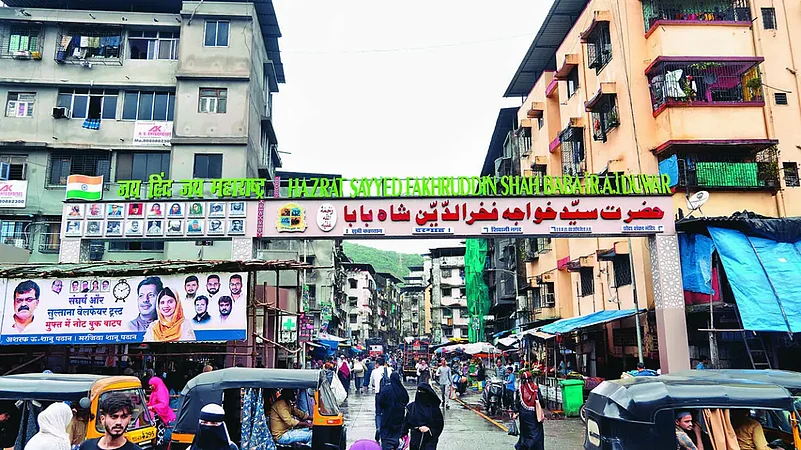There is always at least one flower on the grave of Ishrat Jahan, located in Kawsha Kabristan, about half a kilometre from her home in Rashid Compound, Mumbra. The Gujarat Police had shot Jahan along with three men, branded her as a ‘terrorist’ on a mission to kill the then chief minister Narendra Modi. Jahan’s case aside, the Mumbai Police had arrested Mumbra residents, Yasin Kapadia and Dr Mateen, on terror charges after the Ghatkopar train bomb blasts in 2002. Similarly, after the series of train bomb blasts in 2006, Mumbai Police had picked up Abdul Wahid Shaikh, a school teacher from Mumbra, who was later acquitted. But the flowers are a testimony too. In Mumbra, the place that came up in the aftermath of the riots. Mumbai is also a city of ghettos.
Mumbra, located near Thane creek about 60km from Mumbai, is riddled with derelict structures and modern-day aspirations of its largely subaltern masses. In this working class Muslim ghetto, dreams and nightmares co-exist. The fork on the Kausa road, Mumbra’s main road, stitches this disparity. One road leads to the neglected slums that have become the cynosure of developers and land sharks. The other leads to congested alleys where the once-dirty slums are slowly making way for redevelopment projects that have eaten up open spaces/play areas for children.
Much of the area around Mumbra was earlier agricultural land. From 1968-75, Mumbai saw significant growth in population and area density, and Mumbra’s landscape became urbanised. This was the first expansion of the Mumbai Metropolitan Region of which Mumbra is a part. Till 1991, Mumbra’s population was below 50,000. After the 1992-93 Mumbai riots following the Babri Masjid demolition, many Muslims from Bhandup, Vikhroli, Ghatkopar and Walkeshwar in Mumbai fled to Mumbra. The then state government allocated around 26 sq km that was under the State Waqf Board for the resettlement of displaced Muslims, for whom Mumbra had become the promised land. Mumbra’s population, according to the 2011 Census, rose to over 90,000; 20 times more than what it was before the 1992 riots. While 85 per cent of the population is Muslim, 8.6 per cent are Buddhists, 3 per cent Hindus, 1.4 per cent Christians, 1.7 per cent Jain and 0.3 per cent from other communities. Development has seen the rise of English-medium schools by missionaries and NGOs, followed by Hindi and Marathi-medium schools. Not many madrassas or Urdu-medium schools either. Coaching classes have erected flex banners, displaying names of their students who topped the Class 10 results. Firdaus, employed at a coaching class, tells Outlook that the aspirations of the Muslim community have grown after education seems the gateway to fulfilling dreams.
When the call of azaan reverberates throughout Mumbra, the devout converge at the masjids here. Unlike Mumbai and other parts of Maharashtra, where Raj Thackeray demanded that the loudspeakers in mosques be silenced, here the prayers from the many mosques are played five times a day. Earlier, banks refused to set up branches in Mumbra. Now, several nationalised and private banks have branches and ATMs here. Hindu and Muslim eateries do business side-by-side. Interestingly, the jewellery shops, barring a few, are owned by Hindus.
All the women Outlook spoke to say they move around freely. Majority of them are burqa-clad. “When I lived in Mumbai, one woman would always ask me why I wore a burqa. One day I asked her why she wore a mangalsutra. She created such a ruckus that within a week, my family and I fled to Mumbra because we got death threats,” recalls Alynussa Khan. “Here, there’s peace,” she smiles, adding her health improved after moving to Mumbra. A number of ‘women-only’ gymnasiums cropped up after the local MLA went on a development spree, notes Amjad Khan, a physical trainer. There was an all-girl football team before Covid that took part in tournaments outside Mumbra. “The older girls are busy pursuing higher studies, and a new team is yet to be formed,” informs a source. Yasmin Shaikh, a data analyst with a multinational company, says her family of five can afford a house in Mumbai, but chose to move into a plusher flat within Mumbra. “My parents came here with nothing, and built their life from scratch. We have grown emotionally attached to the place,” says Shaikh. Mustaq Rizvi, a hairstylist at a Mumbra salon, had contemplated relocation some years ago, after feeling cut off from the redevelopment process. “After Jeetendra Awhad sir became the MLA, life has turned for the best,” points out Rizvi. Two gigantic water tanks stand before Parsik Hill. Like a testimony to Mumbra’s burgeoning population and potentially prosperous times ahead.
Haima Deshpande in Mumbra
(This appeared in print as 'Songs Of Suburbia')
















